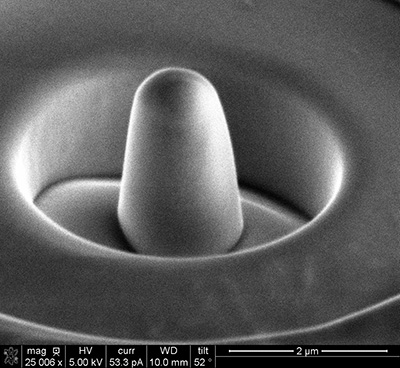Technique Offers Advance in Testing Micro-Scale Compressive Strength of Cement

For Immediate Release
Researchers from North Carolina State University have, for the first time, used a “micropillar compression” technique to characterize the micro-scale strength of cement, allowing for the development of cement with desirable strength properties for civil engineering applications.

“The information collected using this technique can be used to better understand the behavior of concrete when it fails, as well as providing key data for ‘constitutive’ models that are used for designing and determining the safety of large-scale civil engineering structures,” says Rahnuma Shahrin, a civil engineering Ph.D. student at NC State and lead author of a paper on the work.
“The research outcomes will lead to significant impacts in the study of failure of materials containing cement,” Shahrin says. “The production, transportation and use of concrete accounts for between 5 and 9 percent of total carbon dioxide emissions worldwide. The knowledge from this study can be applied toward development of stronger, more sustainable materials for civil infrastructure, reducing consumption of natural resources and production of CO2.”
Cement is used to make concrete, one of the most widely used construction materials in the world. The compressive strength of cement is a primary factor in determining how much load concrete can bear – a critical consideration for civil engineering projects. Engineers have long known that cement derives its strength from an ingredient called calcium silicate hydrate (C-S-H) – the primary product formed when cement powder is mixed with water. Researchers, however, have not been able to measure the compressive strength of the C-S-H in a cement sample – the sample sizes needed for isolating and testing the C-S-H components are too small to fabricate by conventional sample preparation methods.
To address this challenge, the researchers turned to a technique used in materials science called micropillar compression. Normally used on crystalline materials, micropillar compression uses very small samples to determine the compressive strength of a material.
Because cement is a heterogeneous material, made up of multiple components, Shahrin used a scanning electron microscopy/X-ray technique to find the areas in cement samples that had the highest ratio of C-S-H relative to other constituent materials.
Once the C-S-H sites were identified, they were milled into cylinders 2 micrometers wide and 4 micrometers in height. These samples could then be subjected to micropillar compression.
“There are lots of ways to make cement, and it can be made with different constituents in different ratios,” Shahrin says. “We’ve shown that the micropillar technique can be used to give us precise measures of C-S-H compressive strength in these different type of mixtures. This information can be used to help us understand how various processes, and the constituents added during cement production, can affect the cement’s strength. It’s basically a tool that can be used to develop better, stronger cement.”
The paper, “Characterizing strength and failure of calcium silicate hydrate (C-S-H) aggregates in cement paste under micropillar compression,” is published in the Journal of Nanomechanics and Micromechanics. The paper was co-authored by Christopher Bobko, an adjunct associate professor of civil engineering at NC State. The work was supported by the National Science Foundation under grant number 1433054.
-shipman-
Note to Editors: The study abstract follows.
“Characterizing strength and failure of calcium silicate hydrate (C-S-H) aggregates in cement paste under micropillar compression”
Authors: Rahnuma Shahrin and Christopher P. Bobko, North Carolina State University
Published: Oct. 17, Journal of Nanomechanics and Micromechanics
DOI: 10.1061/(ASCE)NM.2153-5477.0000137
Abstract: A new methodology is proposed for investigating compressive failure behavior of cement paste at micrometer scale. Micropillar geometries are fabricated by focused ion beam milling on potential calcium silicate hydrate (C-S-H) locations identified through energy dispersive spectroscopy (EDS) spot analysis. Uniaxial compression testing of these pillars is performed using nanoindentation equipment. The compressive strength of C-S-H aggregates (225-606 MPa) measured from micro-compression tests is found to be consistent with values from multiscale damage and molecular dynamic models. From post-test images, two primary deformation mechanisms at failure were identified; axial splitting and plastic collapse of the entire sample were observed.
- Categories:


